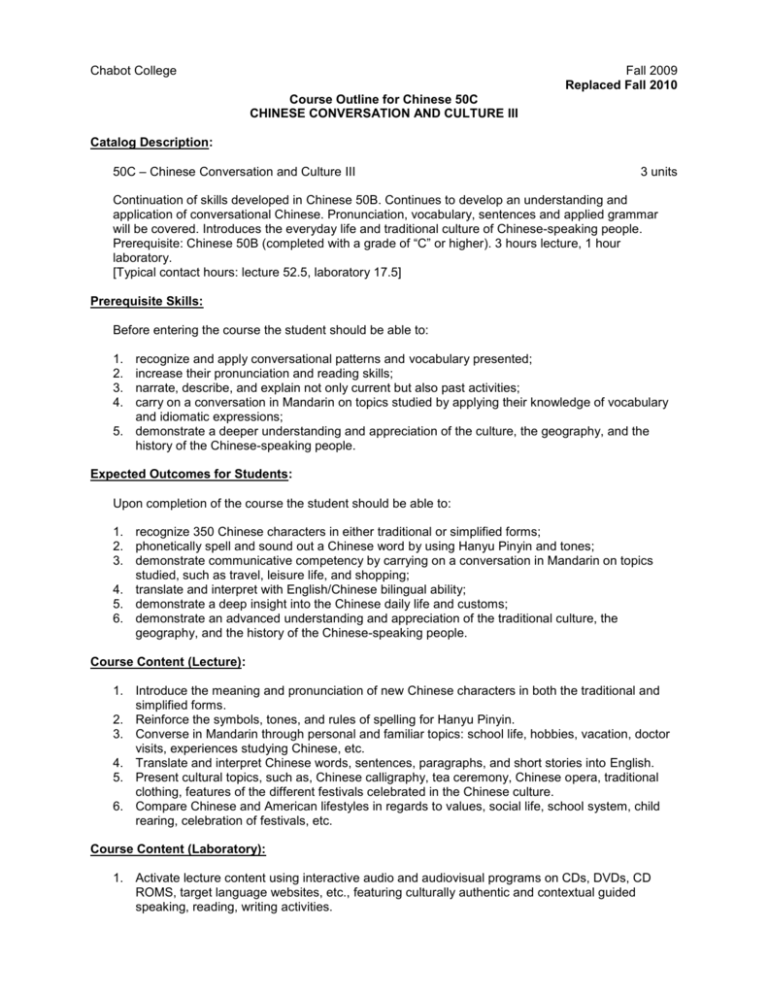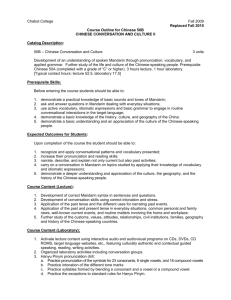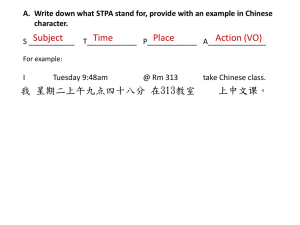Chabot College
advertisement

Chabot College Fall 2009 Replaced Fall 2010 Course Outline for Chinese 50C CHINESE CONVERSATION AND CULTURE III Catalog Description: 50C – Chinese Conversation and Culture III 3 units Continuation of skills developed in Chinese 50B. Continues to develop an understanding and application of conversational Chinese. Pronunciation, vocabulary, sentences and applied grammar will be covered. Introduces the everyday life and traditional culture of Chinese-speaking people. Prerequisite: Chinese 50B (completed with a grade of “C” or higher). 3 hours lecture, 1 hour laboratory. [Typical contact hours: lecture 52.5, laboratory 17.5] Prerequisite Skills: Before entering the course the student should be able to: 1. 2. 3. 4. recognize and apply conversational patterns and vocabulary presented; increase their pronunciation and reading skills; narrate, describe, and explain not only current but also past activities; carry on a conversation in Mandarin on topics studied by applying their knowledge of vocabulary and idiomatic expressions; 5. demonstrate a deeper understanding and appreciation of the culture, the geography, and the history of the Chinese-speaking people. Expected Outcomes for Students: Upon completion of the course the student should be able to: 1. recognize 350 Chinese characters in either traditional or simplified forms; 2. phonetically spell and sound out a Chinese word by using Hanyu Pinyin and tones; 3. demonstrate communicative competency by carrying on a conversation in Mandarin on topics studied, such as travel, leisure life, and shopping; 4. translate and interpret with English/Chinese bilingual ability; 5. demonstrate a deep insight into the Chinese daily life and customs; 6. demonstrate an advanced understanding and appreciation of the traditional culture, the geography, and the history of the Chinese-speaking people. Course Content (Lecture): 1. Introduce the meaning and pronunciation of new Chinese characters in both the traditional and simplified forms. 2. Reinforce the symbols, tones, and rules of spelling for Hanyu Pinyin. 3. Converse in Mandarin through personal and familiar topics: school life, hobbies, vacation, doctor visits, experiences studying Chinese, etc. 4. Translate and interpret Chinese words, sentences, paragraphs, and short stories into English. 5. Present cultural topics, such as, Chinese calligraphy, tea ceremony, Chinese opera, traditional clothing, features of the different festivals celebrated in the Chinese culture. 6. Compare Chinese and American lifestyles in regards to values, social life, school system, child rearing, celebration of festivals, etc. Course Content (Laboratory): 1. Activate lecture content using interactive audio and audiovisual programs on CDs, DVDs, CD ROMS, target language websites, etc., featuring culturally authentic and contextual guided speaking, reading, writing activities. Chabot College Course Outline for Chinese 50C, Page 2 Fall 2009 2. Organized laboratory activities including conversation groups. 3. Hanyu Pinyin pronunciation drill: a. Review consonants, and single and compound vowels b. Review tone marks c. Practice reading sentences and paragraphs written in Hanyu Pinyin Methods of Presentation: 1. 2. 3. 4. Lecture/discussion in target language Choral/individual repetition of model speech Re-creation of dialogues and improvisation Small group activities including oral presentations, skits, and dialogues on topics of interest such as their favorite sports, art, movie, food, job, and vacation. 5. PowerPoint presentation for the comparison study and cultural topics. Assignments and Methods of Evaluating Student Progress: 1. Typical assignments: a. Complete exercises in Student Workbook b. Develop oral presentations based on articles selected from a newspaper, magazine, or downloaded from a website. c. Prepare a skit reflecting a social situation in a culturally appropriate manner, for example, asking directions to the public library. d. Bring to class a favorite object and present it in Mandarin. 2. Method of Evaluating Student Progress: a. Tests and quizzes on material presented, including oral proficiency interviews b. Student participation in class activities c. Homework assignments, such as exercise pages from workbooks d. Final examination Textbook(s) Typical: Integrated Chinese, Tao-Chung Yao, 2nd edition, Chen & Tsui Company: Boston, 2008. Workbook /Character Workbook/Audio CDs Lab Version, 3rd edition, Level 1, Part 1, to accompany Integrated Chinese, Chen & Tsui Company: Boston, 2008. Special Student Materials: Cassette tapes or audio CD with prerecorded lessons from the textbook curriculum 0809 dk 11/13/2008





